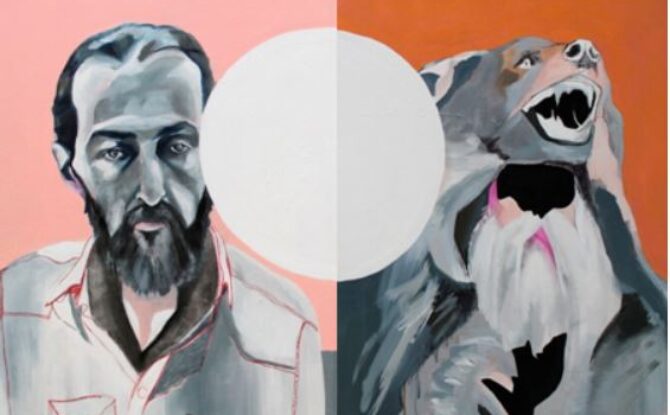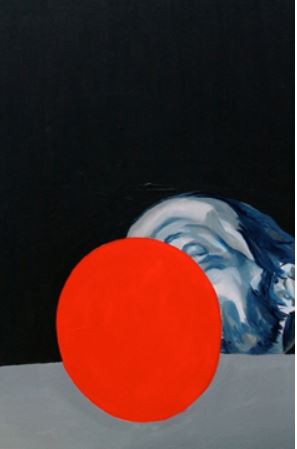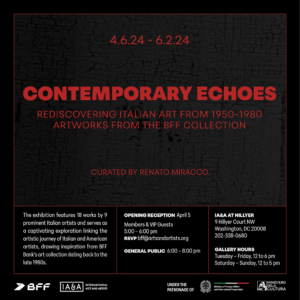
MEMBERSHIP SPOTLIGHT: AMY HUGHES BRADEN
Membership Associate Ginny DeLacey sat down with Amy Hughes Braden as she was installing her show, Red and Grey Paintings, in Hillyer’s NIN9 Members’ Gallery. Amy discussed her fascination with relationships, her issues with ownership and her love of collaboration. Amy’s show will be on view from February 1-25.

Ginny DeLacey: What is your background as an artist?
Amy Hughes Braden: I had supportive parents so I took art classes growing up. It never seemed like an unreasonable idea to be an artist. It was always just the track I was going down.
I went to Pratt right out of high school, but I ended up graduating from the Corcoran. I liked the Corcoran’s program because it was really open and I had a lot of freedom.
GD: Can you discuss the importance of relationships in your paintings and collages?
AHB: Personally, I find family dynamics very interesting. I’m interested in the relationship of relatives, of people you’re related to but you may or may not know. I have a stack of photographs of my grandma when she was about my age that I love to look at because I’m interested in exploring the artifacts of lives lived. Also, I’m a huge extrovert so I need to be constantly interacting with people, even if it’s within a painting.
I’m also into exploring relationships in a more formal way. My husband and I were just discussing how each of the works function more like a paragraph so when you see them all together they are understood in a different, perhaps more complete way.
GD: You’ve recently started mixing painting and collage, could you explain that transition?
AHB: I’ve always kept and collected bits of paper, interesting images from magazines or pamphlets. I have boxes of these papers and every so often I take them out, sort them and reexamine the images. Recently I’ve been using photocopied image. To me they bring up issues of copyright, ownership and authorship in the age of the internet.
I like to take other people’s work and use it in mine. I’ve stolen my brother’s sketchbook and built works on top of his art. I call it a collaboration, but sometimes he gets mad at me. I look at it as I’m not doing anything new, no one’s doing anything new so I think it’s silly to cling onto claims of ownership.
GD: What artists or artistic movements inspire you?
AHB: I’m so bad at answering that question. Francis Bacon and Philip Guston have inspired some of my recent work. The Dada movement has always been appealing to me; they were just fed up with everything. I think their ideas still have a lot of relevance today.
GD: When you start a work do you have a final painting in mind or does it evolve as you go?
AHB: Sometimes they evolve. One of the paintings in this show was originally a portrait that I had done for my thesis. I decided I didn’t want it anymore so I painted over all but one tiny section. I’m very reactionary when I paint, which can get me into trouble. I use source images for any figures that I include in my work, but I don’t usually have the whole composition pre-planned. Like I said, I’m reactionary. I’m very impatient when I paint, which is one reason why I don’t use oils. I work very impulsively and instinctually.
GD: How long does it take you to create a work?
AHB: It depends. I always work on at least three paintings at a time and then I always have a few collages going at once. I’ve found that this helps me make better decisions, or it keeps me from getting tunnel vision on one piece and overworking it. I made that painting [referring to Mrs. Henry White, above] in three hours. I was challenged to create a painting in three hours and that was the end result. There was a lot of energy going into it, knowing I had such a limited amount of time to work, and I became less inhibited. I only had time to execute my idea; there was no time to hem and haw over the process.
But then other paintings can take months. I don’t necessarily churn out works quickly, but I do like to make marks and paint quickly. Sometimes I’ll start a painting and then set it aside for a few months to mull over before working on it again. I didn’t always do this, but I’ve seen that it is a vital part of the process.
GD: When you work on paintings or collages at the same time, do they wind up looking similar?
AHB: Yes, because I use the same palette on each one so the colors are fairly consistent in each painting. When I paint, I paint whatever I’m thinking about. It’s very stream of consciousness so the works come from the same head space which makes them thematically similar by default.
GD: Do you think this show has an overall theme?
AHB: I didn’t have a theme in mind at the start so it’s hard for me stand back now and say, “Oh, this is the theme.” I’ve always worked with portraiture so formally these paintings are about trying to evolve from simply rendering faces on a canvas. I thought a lot about formal elements as I painted and also about how to incorporate collage elements into the paintings, while maintaining a level of refinement. Ideas about my family and relationships on all levels will always be a part of my work and I believe that shows here as well.
–
Come visit Amy’s show Red and Grey Paintings along with John Reuss’ Mind & Matter and Marcia Wolfson Ray’s Rhythms on view in Hillyer until February 25.


